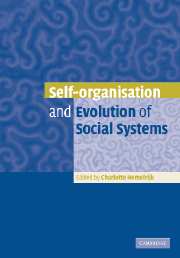Book contents
- Frontmatter
- Contents
- List of contributors
- Preface
- Introduction
- 1 From unicellular to multicellular organisation in the social amoeba Dictyostelium discoideum
- 2 Optimality of communication in self-organised social behaviour
- 3 The interplay of intracolonial genotypic variance and self-organisation of dominance hierarchies in honeybees
- 4 Traffic rules of fish schools: a review of agent-based approaches
- 5 A process-oriented approach to the social behaviour of primates
- 6 Order and noise in primate societies
- 7 Self-organisation in language
- 8 Dictatorship effect of majority rule in voting in hierarchical systems
- 9 Natural selection and complex systems: a complex interaction
- 10 Interlocking of self-organisation and evolution
- Index
- References
7 - Self-organisation in language
Published online by Cambridge University Press: 07 December 2009
- Frontmatter
- Contents
- List of contributors
- Preface
- Introduction
- 1 From unicellular to multicellular organisation in the social amoeba Dictyostelium discoideum
- 2 Optimality of communication in self-organised social behaviour
- 3 The interplay of intracolonial genotypic variance and self-organisation of dominance hierarchies in honeybees
- 4 Traffic rules of fish schools: a review of agent-based approaches
- 5 A process-oriented approach to the social behaviour of primates
- 6 Order and noise in primate societies
- 7 Self-organisation in language
- 8 Dictatorship effect of majority rule in voting in hierarchical systems
- 9 Natural selection and complex systems: a complex interaction
- 10 Interlocking of self-organisation and evolution
- Index
- References
Summary
Definition of self-organisation
Many papers that describe processes resembling self-organisation according to the definition used here do not explicitly use the term ‘self-organisation’. Instead terms like ‘emergent behaviour’, ‘population dynamics’, ‘bifurcations’, ‘catastrophes’ and others are used. In this chapter, such work will be subsumed under self-organisation. There might be slight differences in the phenomena that are described, but the basic ideas are the same, and an overview of this kind of work would be incomplete if attention was focused on only those papers that contain the term self-organisation.
Another reason why the term self-organisation is not used more frequently might be that the term itself is ill-defined. Different authors use different interpretations of the term. A selection of linguistic papers with self-organisation in the title (Lindblom et al., 1984; Wildgen, 1990; Steels, 1995; Ehala, 1996; Demolin and Soquet, 1999; de Boer, 2000; Nicolis et al., 2000) all have a slightly different view on what it is and what role it plays. Further, the term self-organisation might not be popular among linguists, because it has the negative connotation of being vague.
It is therefore useful and instructive to study in some more depth the definition of self-organisation used here. Self-organisation, according to this definition is ‘The emergence of order on a global scale through interactions on a local scale.’ The definition assumes there is a system that has two main components: actors and interactions.
- Type
- Chapter
- Information
- Self-Organisation and Evolution of Biological and Social Systems , pp. 123 - 139Publisher: Cambridge University PressPrint publication year: 2005
References
- 2
- Cited by

